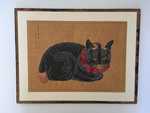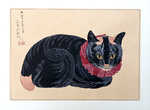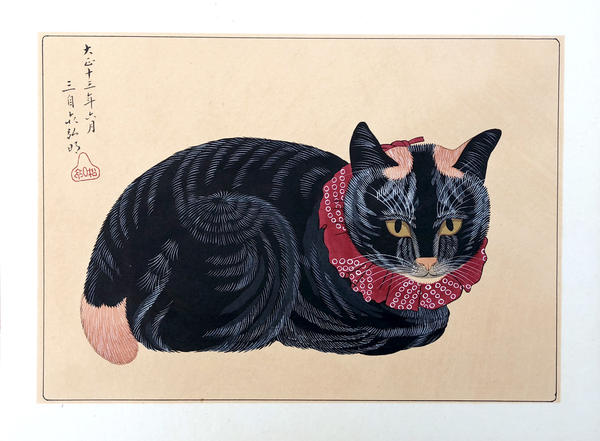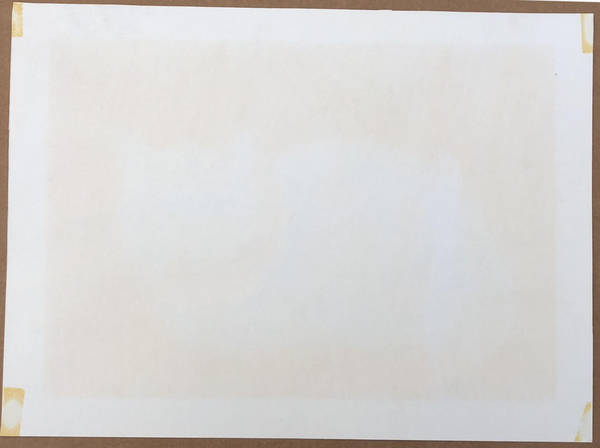| | |
| Artist: | Shotei Takahashi (1871-1945) Hiroaki — 松亭高橋、弘明 |
| Title: | Tama |
| Series: | |
| Date of first edition?: | 1924/6 |
| Publisher (first edition)?: | Self |
| Publisher (this edition)?: | Self |
| Medium (first edition): | Watercolour |
| Medium (this edition): | Watercolour |
| Format (first edition): | Oban
|
| Format (this edition): | Oban |
| DB artwork code: | 47130 |
| Notes (first edition)?: |
Apparently there are several examples of this painting, along with examples of a white cat too. From Marc Kahn:
Looking at "image1.JPG" from your initial email, it looks like it validates some discussions that I've had with the other collector who has another
pair of black/white cats. Our hypothesis is that the 3-D format of the paper, with the center popped up above the level of the borders, was caused by there being an insert behind the paper which is smaller than the matte window opening. It looks like that's the situation with your painting.
Since there are multiple copies of the same paintings, we figured that there must have been a promoter who hired Shotei to do these paintings and then framed and sold them. Takahashi Shotei was an artist, but it's doubtful that he would have been the packager of this work.
Original auction listing:
This painting depicts a Black Cat. Takahashi Hiroaki (1871-1945) Shotei. This Black Cat with Red Scarf against a blank background is an extremely rare piece. This is dated 1924, post earthquake, with a seal, color on paper, framed. Painting is approximately 9 3/4 x 13 5/8.
This would appear to be the companion to the "Tama" white cat work from 1924. While the "Tama" print is commercially available this Black Cat print is not.
This piece is still in its original frame.
Several experts have commented on it and while it is never definitive if it is an "after print" by an under study or a preparatory drawing by his hand there is belief that is an original Shotei. |
|
| Notes (this edition)?: |
| The following information was taken from the original web listing of this artwork. Note that there may be some inaccuracies:
Artist: Hiroaki (Shotei) Takahashi (1871-1945)
Title: Tama
Size: Oban; 13 1/4" x 9 1/2" + Margins as shown (34 x 24 cm + margins) |
|
| Artist Bio: |
Takahashi Shotei was born in Tokyo with the given name of Takahashi Katsutaro. At a young age he was trained in Nihon-ga , the traditional Japanese painting style by his uncle Matsumoto Fuko, and beginning around 1907 Shotei started designing for the Watanabe Color Print Company. Shotei was among the first designers to be recruited into Watanabe's stable of artists, which would later expand to include Goyo, Shinsui, Hasui, Kasamatsu, Koson and Koitsu among others. Many Watanabe prints were designed for export, primarily to North America, where the demand for all things Japanese was high in the early 20th century.
By 1923 Shotei had produced nearly 500 designs for Watanabe, when Tokyo was hit by the Great Kanto earthquake -- the worst recorded natural catastrophe in the history of Japan. The fires ignited by the earthquake raged for three days, and Watanabe's print shop and all the woodblocks created by Shotei and the other early shin hanga artists, were destroyed.
After the earthquake Shotei created another 250 prints mostly depicting scenic Japanese landscapes in the shin hanga style he had helped to define. He continued to work for Watanabe, but also worked with the publishers Fusui Gabo and Shobido Tanaka, where he had more control over the finished print than was possible with Watanabe.
Shotei used a variety of names, signatures and seals during his lifetime. From 1907 until 1922 he used the name Shotei, and after 1922 Hiroaki and Komei.
|
|






